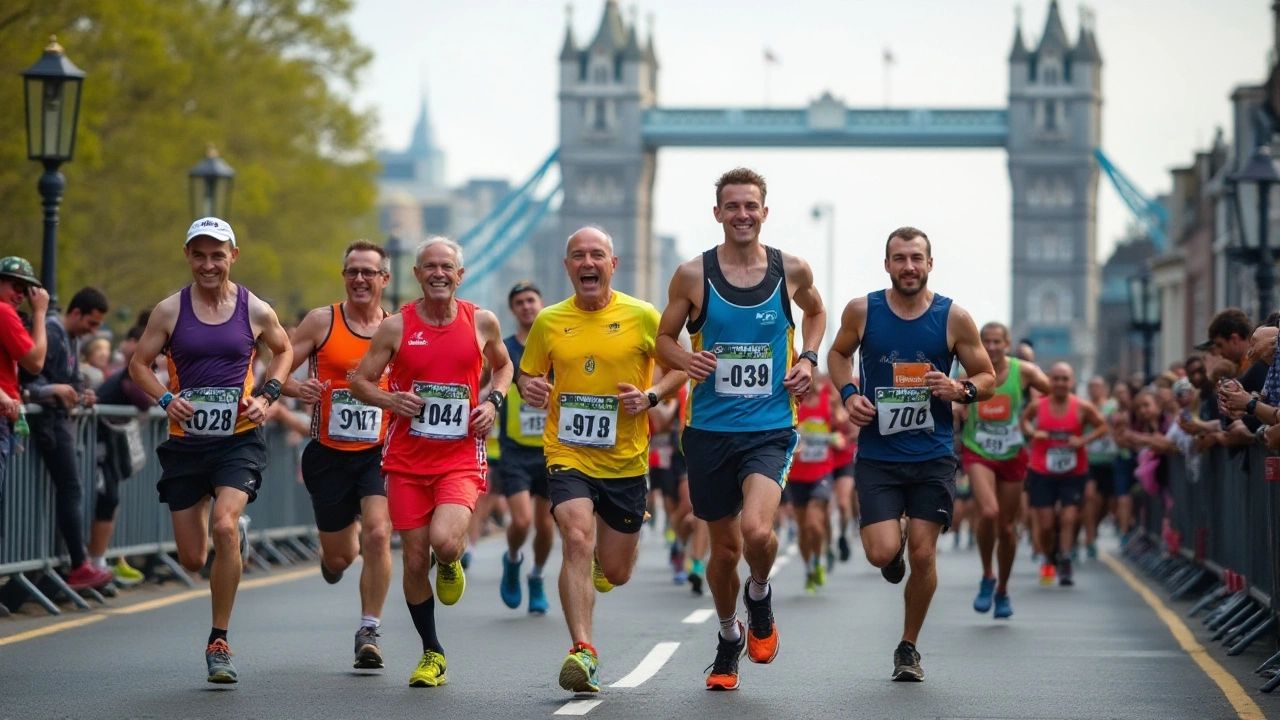What is a Realistic Marathon Finishing Time for Different Runners?

Training for a marathon requires determination, grit, and a realistic understanding of what you're aiming for. Whether you're a seasoned runner or a first-timer, setting an achievable marathon time is crucial. But what does 'realistic' really mean when it comes to pacing yourself over 26.2 miles?
For many, finishing in itself is a remarkable achievement, while others might focus on a specific goal, such as qualifying for the coveted Boston Marathon. Regardless of where you stand, understanding various factors can influence your finish time—from your age and experience to the conditions on race day.
We'll delve into these aspects and provide handy tips, helping you to tailor your training to meet personal bests while maintaining a sensible approach to marathon running. Whether you're chasing a personal record or just hoping to cross that finish line with a smile, here's what you need to know about setting a realistic marathon time.
- Understanding Marathon Finishing Times
- Factors Influencing Your Marathon Time
- Age, Experience, and Performance
- Setting Achievable Running Goals
- Real-life Marathon Time Examples
Understanding Marathon Finishing Times
Running a marathon is an extraordinary endeavor, both mentally and physically demanding. Historically, marathon finishing times have been a topic of fascination, puzzling both spectators and participants alike. From elite athletes completing the race in just over two hours to novice runners pushing through injury to finish, the range of completion times is vast and varied. Understanding these times requires delving into various components that determine pacing and eventual performance. For instance, elite athletes like Eliud Kipchoge have smashed records, running 2:01:39 in Berlin, 2022, a feat that spells out the zenith of human running potential.
However, it is not just about glory and records. For most of us, understanding a realistic marathon time means aligning our expectations with our individual fitness levels, preparation, and goals. Looking through data from events worldwide, the average finish time for recreational runners lies around 4 to 4.5 hours. This statistic offers a broad benchmark but does not dictate personal potential or success. Knowing where you stand within this spectrum is critical to setting a target that is achievable yet challenging enough to keep you motivated.
“To go fast, go alone. To go far, go together.” This popular running adage highlights not just the need for community in reaching goals but also a reminder that pacing is crucial – it’s not about how fast you start but how strong you finish.
The disparity in marathon times is often attributed to several key factors. Availability of resources, training regimen styles, weather conditions on race day, and personal health all contribute to what can be accomplished across those 26.2 miles. Consider the conditions in the London Marathon of 2018, which was marked by unprecedented heat, affecting overall race times. Understanding these dynamics can aid runners in making informed decisions about their strategies.
For newer runners aspiring to complete their first marathon, it’s understandable to be inundated with questions about what is 'normal' or 'expected'. However, it is essential to define what your marathon means to you. While some are inspired to hit a sub-3-hour mark, others find victory in simply crossing the finish line upright. Both are accomplishments worthy of praise.
When social media floods our consciousness with impressive finishes from running influencers and elite runners, it is vital to ground our expectations in reality. Visualizing success—whether through mental rehearsals or simply plotting mile times that align with your current pace—can keep you focused and patient. To understand your own potential, it may be helpful to engage with regression analysis, a statistical method that correlates your consistent past performances to forecast an achievable marathon time.
Factors Influencing Your Marathon Time
Your marathon finishing time is not just about how fast you can sprint across the starting line. It’s a complex tapestry woven from numerous threads that together dictate how your race will unfold. One of the most significant factors is your level of marathon training. The extent to which you've prepared your body to endure the 26.2 miles is crucial. Training not only conditions your muscles but also builds mental stamina, essential in combating those infamous ‘walls’ runners hit in the latter stages. Proper marathon training often involves a mix of long runs, speed work, and cross-training, balanced well enough to avoid the equally dreaded injury.
Speaking of terrain and environment, both play pivotal roles in your marathon time. The course's elevation can either be your best friend or your worst enemy. A hilly course will slow practitioners down, while a flat route is generally more forgiving. Weather conditions cannot be overlooked; the perfect marathon happens in mild weather, cool and dry. However, if you're surprised with a warm and humid day, your performance could suffer. Running goals must be flexible enough to adapt to these uncontrollable factors, allowing a realistic reassessment of finishing times without harsh self-judgment.
Diet and nutrition, during both the build-up to your marathon and on race day, are mere appearances in some training plans, though they tremendously affect performance. Carbohydrate loading, maintaining electrolyte balance, and staying hydrated are all ingredients in the recipe for success. Without the right nutritional strategies, even the most well-trained athlete can see performance decline as they deplete their energy reserves mid-race. Experienced marathoners know the importance of fueling with gels and drinks during the race, often timing these precisely to maintain their pace.
"Marathons are about consistency, in training, in nutrition, and on the day itself." - Paula Radcliffe, Marathon World Record Holder
The mental aspect should not be underestimated either. Going through the rigors of marathon length requires a mindset that’s both resilient and adaptable. Psychological preparedness can often distinguish between those who thrive and those who merely survive when faced with trail challenges or unexpected disruptions. Visualization techniques, pre-race routines, and positive reaffirmations are psychological tools that marathoners incorporate into their preparation to enhance their mental edge.
Recent studies in sports science emphasize the contribution of running economy—a measure of how effectively a runner uses oxygen while running at a specific pace. Variables from biomechanics, such as stride length and efficiency, to physiological factors like VO2 max, indicate how these translate into a finely tuned marathon performance. Improving running form and incorporating varied paces into training can enhance running economy and result in a better overall time. With these factors in mind, it becomes clear that a realistic marathon goal is not just about numbers; it’s about understanding and optimizing all aspects of your preparation.

Age, Experience, and Performance
Running a marathon is a unique challenge for every runner, deeply influenced by their age, past experiences, and current performance levels. As one grows older, both physical endurance and mental resilience evolve, impacting marathon performance. Older runners often bring to the race a wealth of experience, understanding their body's signals more intimately and pacing themselves effectively. They might have learned the subtle art of conserving energy in the first half of the race, ensuring they have the endurance to finish strong, a skill that younger, less experienced runners are yet to perfect.
Conversely, younger runners, often at the peak of their physical prowess, may have an edge in speed and muscle recovery. Yet, they might underestimate the mental taxing nature of the marathon distance. Ages ranging between 30-35 are generally noted as peak years for marathon performance. This period balances youthful energy and maturity in race strategy. However, it is noteworthy that runners in their 40s and beyond still showcase impressive times. In fact, according to research by Masters Athletics, performance decrement accelerates from around age 50, but many in their 40s can still clock times that rival younger competitors.
Experience is another powerful influencer. A seasoned marathoner understands the importance of building mileage progressively and the nuances of energy gels and hydration during long runs. They might have several half-marathons under their belt, each one teaching a lesson about pacing and mental fortitude. A first-time marathoner, however, faces a steep learning curve; but that first finish line offers invaluable insights for future races. As the adage goes, 'Practice makes perfect,' and in marathon running, this is profoundly true.
Performances are also a testimony to one's consistent training dedication. Those who integrate running into their daily life see greater improvements. Age isn't the only factor; it's how you blend age with experience and consistent performance improvement that counts. IEEE Spectrum mentions that older runners who consistently train with intensity, even into their 60s, often surprise themselves and others with how they improve marathon times against what one expects with age. In dimensions like this, the fusion of experience and performance becomes more significant than age itself.
Setting Achievable Running Goals
When embarking on the journey of marathon training, setting achievable running goals is essential. This is not merely about the glory of finishing, but also ensuring you reach the finish line in a way that reflects your hard work and preparation. First and foremost, you need to assess your current fitness level. Consider how frequently you run, how many miles you cover each week, and any past experiences in races. If you're stepping up from the world of 5Ks or half-marathons, transitioning requires patience and a realistic timeline to avoid injuries.
A good starting point is establishing your primary goal, whether it's just to finish, beat a personal record, or run a specific time. Breaking down this ultimate ambition into smaller, achievable steps can keep you motivated. An effective approach is to set short-term goals that contribute to your long-term objective, such as gradually increasing your weekly mileage. As you build towards your marathon, you should aim for one long run each week to test your endurance, ideally increasing this distance incrementally.
"The miracle isn't that I finished. The miracle is that I had the courage to start," said John Bingham, a respected voice in the running community, reminding us that starting the journey often carries the most courage.
Another vital component in setting and achieving realistic goals is understanding pace. If springing past numerous racers in the first mile raises suspicion of zeal, think again. Establish an honest, sustainable pace during training. While you might daydream about crossing the finish line ahead of the masses, gauging how strong you feel across various distances will aid you in tailoring a pace plan for race day. Many find that participating in shorter races as part of the preparation provides valuable speed practice and motivation along the way.
For those who relish numbers, incorporating data into goal-setting can be quite enlightening. Review your past race stats, if available, and use them to predict your capability. If data collection intrigues you, making the most out of apps and devices that track your runs can ensure you're on the right path. Here's a simple breakdown:
| Training Phase | Weekly Mileage | Long Run (miles) | Pace Improvement |
|---|---|---|---|
| Initial Weeks | 20-25 miles | 8-10 miles | Base Building |
| Mid Training | 30-35 miles | 12-16 miles | Speed & Endurance |
| Peak | 40+ miles | 18-22 miles | Race Readiness |
Beyond statistics, find a training plan that suits your lifestyle. Whether it's a regimented schedule from a book, an app, or a mentor, consistency is crucial. Yet, flexibility plays no less a role—life happens, and adapting to it shows strength. Remember, goals should be as much about enjoying the journey as reaching the destination. Celebrate small victories, keep a positive mindset, and always seek joy in the process, ensuring perseverance even when the weather’s grim or motivation wanes.

Real-life Marathon Time Examples
In the quest to understand what constitutes a realistic marathon time, it's helpful to look at the diverse experiences of runners who have embarked on this Herculean journey. There isn't a 'one-size-fits-all' answer because each runner's journey is shaped by unique factors ranging from training intensity, physical condition, to the course itself. However, it's inspiring to delve into some examples that highlight the triumphs and trials of various marathoners. These examples provide not just benchmark times but showcase the human spirit's resilience and diversity.
Starting with elite runners, Kipchoge's sub-two-hour marathon in a non-competitive setting was an astonishing feat of human capability. His remarkable achievement didn't just set a new bar but also sparked global conversations about human limitations and possibilities in running. While top marathoners can consistently clock in under two and a half hours, we must remember that these figures emerge from meticulously optimized training schedules and conditions. For most seasoned non-elite runners, completing a marathon in under four hours represents an equally impressive realm of accomplishment.
For average participants, crossing the finish line anywhere between four to five hours is typical. However, the beauty of marathon racing is in its inclusivity, welcoming runners who may take longer. In fact, charity runners, first-timers, and those simply running for the love of it might plan to finish within six or seven hours. This is not a mark of failure but a testament to personal endurance and dedication. As Runner's World aptly puts it, "The marathon is a race against the distance, not the clock." In thinking about what a realistic marathon time might be for you, these reflective anecdotes are a gentle reminder that every runner's marathon story is uniquely theirs.
Statistics reveal fascinating insights as well. For instance, according to a survey, the average marathon finishing time for men is approximately 4:30 hours, while women tend to finish around 4:56 hours. These figures underscore how gender can influence performance while also highlighting the progress women have made in endurance sports. A traditional table might illustrate:
| Gender | Average Finish Time |
|---|---|
| Men | 4:30 hours |
| Women | 4:56 hours |
Ultimately, gaining insight from these real-world examples is about acknowledging the rich tapestry of marathon experiences. It's about celebrating accomplishments across a broad spectrum, from those breaking records to those overcoming personal battles to complete the journey. Let these stories inspire your training approach and goal-setting, as they remind us that marathons are more about the journey than the destination.
